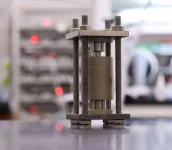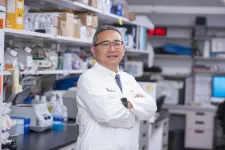(Press-News.org) Using X-ray tomography, a research team has observed the internal evolution of the materials inside solid-state lithium batteries as they were charged and discharged. Detailed three-dimensional information from the research could help improve the reliability and performance of the batteries, which use solid materials to replace the flammable liquid electrolytes in existing lithium-ion batteries.
The operando synchrotron X-ray computed microtomography imaging revealed how the dynamic changes of electrode materials at lithium/solid-electrolyte interfaces determine the behavior of solid-state batteries. The researchers found that battery operation caused voids to form at the interface, which created a loss of contact that was the primary cause of failure in the cells.
"This work provides fundamental understanding of what is happening inside the battery, and that information should be important for guiding engineering efforts that will push these batteries closer to commercial reality in the next several years," said Matthew McDowell, an assistant professor in the George W. Woodruff School of Mechanical Engineering and the School of Materials Science and Engineering at the Georgia Institute of Technology. "We were able to understand exactly how and where voids form at the interface, and then relate that to battery performance."
The research, supported by the National Science Foundation, a Sloan Research Fellowship, and the Air Force Office of Scientific Research, will be reported January 28 in the journal Nature Materials.
The lithium-ion batteries now in widespread use for everything from mobile electronics to electric vehicles rely on a liquid electrolyte to carry ions back and forth between electrodes within the battery during charge and discharge cycles. The liquid uniformly coats the electrodes, allowing free movement of the ions.
Rapidly-evolving solid state battery technology instead uses a solid electrolyte, which should help boost energy density and improve the safety of future batteries. But removal of lithium from electrodes can create voids at interfaces that cause reliability issues that limit how long the batteries can operate.
"To counter this, you could imagine creating structured interfaces through different deposition processes to try to maintain contact through the cycling process," McDowell said. "Careful control and engineering of these interface structures will be very important for future solid-state battery development, and what we learned here could help us design interfaces."
The Georgia Tech research team, led by first author and graduate student Jack Lewis, built special test cells about two millimeters wide which were designed to be studied at the Advanced Photon Source, a synchrotron facility at Argonne National Laboratory, a U.S. Department of Energy Office of Science facility located near Chicago. Four members of the team studied the changes in battery structure during a five-day period of intensive experiments.
"The instrument takes images from different directions, and you reconstruct them using computer algorithms to provide 3-D images of the batteries over time," McDowell said. "We did this imaging while we were charging and discharging the batteries to visualize how things were changing inside the batteries as they operated."
Because lithium is so light, imaging it with X-rays can be challenging and required a special design of the test battery cells. The technology used at Argonne is similar to what is used for medical computed tomography (CT) scans. "Instead of imaging people, we were imaging batteries," he said.
Because of limitations in the testing, the researchers were only able to observe the structure of the batteries through a single cycle. In future work, McDowell would like to see what happens over additional cycles, and whether the structure somehow adapts to the creation and filling of voids. The researchers believe the results would likely apply to other electrolyte formulations, and that the characterization technique could be used to obtain information about other battery processes.
Battery packs for electric vehicles must withstand at least a thousand cycles during a projected 150,000-mile lifetime. While solid-state batteries with lithium metal electrodes can offer more energy for a given size battery, that advantage won't overcome existing technology unless they can provide comparable lifetimes.
"We are very excited about the technological prospects for solid-state batteries," McDowell said. "There is substantial commercial and scientific interest in this area, and information from this study should help advance this technology toward broad commercial applications."
INFORMATION:
In addition to those already mentioned, co-authors included Francisco Javier Quintero Cortes, Yuhgene Liu, John C. Miers, Jared Tippens, Dhruv Prakash, Thomas S. Marchese, Sang Yun Han, Chanhee Lee, Pralav P. Shetty and Christopher Saldana from Georgia Tech; Ankit Verma, Bairav S. Vishnugopi, and Partha P. Mukherjee from Purdue University; Hyun-Wook Lee from Ulsan National Institute of Science and Technology; and Pavel Shevchenko and Francesco De Carlo from Argonne National Laboratory.
This work is partially supported by the National Science Foundation under Award No. DMR-1652471, a Sloan Research Fellowship in Chemistry, a NASA Space Technology grant, the Colciencias-Fulbright scholarship program cohort 2016, the Ministry of Trade, Industry & Energy/Korea Institute of Energy Technology Evaluation and Planning (MOTIE/KETEP)(20194010000100), the Air Force Office of Scientific Research (AFOSR) under Grant FA9550-17-1-0130, and the Scialog program sponsored jointly by Research Corporation for Science Advancement and the Alfred P. Sloan Foundation that includes a grant to Purdue University by the Alfred P. Sloan Foundation. This research used resources of the Advanced Photon Source, a U.S. Department of Energy (DOE) Office of Science User Facility operated for the DOE Office of Science by Argonne National Laboratory under Contract No. DE-AC02-06CH11357. Any opinions, findings, and conclusions or recommendations expressed in this material are those of the authors and do not necessarily reflect the views of the sponsoring agencies.
Science is society's best method for understanding the world, yet many people in the field are unhappy with the way it works. Rules and procedures meant to promote innovative research can have perverse side-effects that harm both science and scientists. One of these - the 'priority rule' - rewards scientists who make discoveries with prestige, prizes and better career opportunities, depriving the runners-up of similar perks. Researchers at University of Technology Eindhoven (TU/e) and the Arizona State University in the US have developed a new model to better understand this rule, and see if current reforms to improve the system actually make sense. Their study was published in Nature Human Behaviour.
"Over the past decade, there have been growing concerns that something ...
What The Study Did: This study finds that being a health care worker isn't associated with poorer outcomes among patients hospitalized with COVID-19.
Authors: Nauzer Forbes, M.D., M.Sc., of the University of Calgary in Canada, is the corresponding author.
To access the embargoed study: Visit our For The Media website at this link https://media.jamanetwork.com/
(doi:10.1001/jamanetworkopen.2020.35699)
Editor's Note: The article includes conflict of interest disclosures. Please see the article for additional information, ...
Risky behaviors such as smoking, alcohol and drug use, speeding, or frequently changing sexual partners result in enormous health and economic consequences and lead to associated costs of an estimated 600 billion dollars a year in the US alone. In order to define measures that could reduce these costs, a better understanding of the basis and mechanisms of risk-taking is needed.
Functional and anatomical differences
UZH neuro-economists Goekhan Aydogan, Todd Hare and Christian Ruff, together with an international research team looked at the genetic characteristics that correlate with risk-taking behavior. Using a representative sample of 25,000 people, the researchers examined the relationship ...
BOSTON - A nationwide panel of experts has developed the first mammography guidelines for older survivors of breast cancer, providing a framework for discussions between survivors and their physicians on the pros and cons of screening in survivors' later years.
The guidelines, published online today in a paper in JAMA Oncology, recommend discontinuing routine mammograms for survivors with a life expectancy under five years; considering stopping screening for those with a 5-10-year life expectancy; and continuing mammography for those whose life expectancy is greater than 10 years. The guidelines will be complemented by printed materials to help survivors gauge their risk of cancer recurring in the breast and weigh the potential benefits and drawbacks of mammography with ...
Science is society's best method for understanding the world. Yet many scientists are unhappy with the way it works, and there are growing concerns that there is something "broken" in current scientific practice. Many of the rules and procedures that are meant to promote innovative research are little more than historical precedents with little reason to suppose they encourage efficient or reliable discoveries. Worse, they can have perverse side-effects that harm both science and scientists. A well-known example is the general preference for positive over negative results, which creates a "publication bias" that gives the false ...
CLEVELAND - Cleveland Clinic researchers have described for the first time how Zika virus (ZIKV) causes one of the most common birth defects associated with prenatal infection, called brain calcification, according to new study findings published in Nature Microbiology.
The findings may reveal novel strategies to prevent prenatal ZIKV brain calcification and offer important insights into how calcifications form in other congenital infections.
"Brain calcification has been linked to several developmental defects in infants, including motor disorders, cognitive disability, eye abnormalities, hearing deficits and seizures, so it's important to better understand the mechanisms of how they develop," said Jae Jung, ...
Advances in DNA sequencing have uncovered a rare syndrome which is caused by variations in the gene SATB1.
The study, co-authored by academics from Oxford Brookes University (UK), University of Lausanne (Switzerland), Radboud University (The Netherlands), University of Oxford (UK), University of Manchester (UK) and led by Max Planck Institute for Psycholinguistics (The Netherlands), discovered three classes of mutations within the gene SATB1, resulting in three variations of a neurodevelopmental disorder with varying symptoms ranging from epilepsy to muscle tone abnormalities.
Recognition of disorder will increase understanding and diagnosis
An international team of geneticists and clinicians from 12 countries identified 42 patients with mutations in the gene ...
People with sleep disorders commonly have a misperception about their actual sleep behaviour. A research group led by Karin Trimmel and Stefan Seidel from MedUni Vienna's Department of Neurology (Outpatient Clinic for Sleep Disorders and Sleep-Related Disorders) analysed polysomnography results to identify the types of sleep disorder that are associated with a discrepancy between self-reported and objective sleep parameters and whether there are any factors that influence this. The main finding: irrespective of age, gender or screening setting, insomnia patients are most likely to underestimate how long they sleep. The study has been published in the highly regarded Journal of Clinical Sleep Medicine.
Patients' misperceptions about the actual time that they sleep is a well-known ...
The ability to manipulate near-infrared (NIR) radiation has the potential to enable a plethora of technologies not only for the biomedical sector (where the semitransparency of human tissue is a clear advantage) but also for security (e.g. biometrics) and ICT (information and communication technology), with the most obvious application being to (nearly or in)visible light communications (VLCs) and related ramifications, including the imminent Internet of Things (IoT) revolution. Compared with inorganic semiconductors, organic NIR sources offer cheap fabrication over large areas, mechanical flexibility, conformability, ...
Mass spectrometers are widely used to analyze highly complex chemical and biological mixtures. Skoltech scientists have developed a new version of a mass spectrometer that uses rotation frequencies of ionized molecules in strong magnetic fields to measure masses with higher accuracy (FT ICR). The team has designed an ion trap that ensures the utmost resolving power in ultra-strong magnetic fields. The research was published in the journal Analytical Chemistry.
The ion trap is shaped like a cylinder made up of electrodes, with electric and magnetic fields generated inside. The exact masses of the test sample's ions can be determined from their rotation frequencies. The electrodes must create a harmonized field of a particular shape ...





